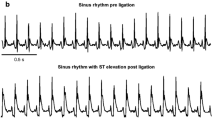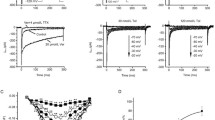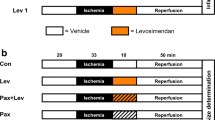Summary
We tested 5-hydroxydecanoate (5-HD), a specific blocker of ATP-sensitive potassium channels (IK.ATP), to determine if it mitigates electrophysiologic changes produced by regional myocardial ischemiain vivo. A sequence of 5-minute occlusion of the distal LAD and 30-minute reperfusion was repeated while recording the monophasic action potential (MAP) and bipolar electrogram (EG) from the epicardial center of the ischemic myocardium in anesthetized dogs. 5-HD (30 mg/kg, IV) or glibenclamide (0.15 or 0.3 mg/kg, IV) was administered before the third occlusion, and the data were compared to the second occlusion data. 5-HD did not affect baseline MAP duration at 90% and 50% repolarization (APD90, APD50) before LAD occlusion but suppressed occlusion-induced shortening of APD90 (16 ± 2% during the second occlusion vs. 5 ± 3% during the third occlusion, n=8, p<0.01) and APD50 (16 ± 3% vs. 10 ± 3%, n=8, p<0.05). Pretreatment with glibenclamide also suppressed occlusion-induced MAP shortening and eliminated an additional effect of 5-HD (n = 3). 5-HD did not affect the occlusion-induced increase in duration and activation time of EG. 5-HD, as well as glibenclamide, suppressed regional ischemia-induced MAP shortening, probably by blocking activation of IK.ATP, without affecting conduction delay. These differential effects of 5-HD on repolarization and conduction during the early phase of regional ischemia might have the potential to suppress reentrant ventricular arrhythmias.
Similar content being viewed by others
References
Noma A. ATP-regulated K+ channels in cardiac muscle.Nature 1983;305:147–148.
Wilde AMM, Escande D, Schumacher CA, et al. Potassium accumulation in the globally ischemic mammalian heart: A role for the ATP sensitive potassium channel.Circ Res 1990;67:835–843.
Kantor PF, Coetzee WA, Carmeliet EE, Dennis SC, Opie LH. Reduction of ischemic K+ loss and arrhythmias in rat hearts: Effect of glibenclamide, a sulfonylurea.Circ Res 1990;66:478–485.
Bekheit SS, Restivo M, Boutjdir M, et al. Effects of glyburide on ischemia-induced changes in extracellular potassium and local myocardial activation: A potential new approach to the management of ischemia-induced malignant ventricular arrhythmias.Am Heart J 1990;119:1025–1033.
Yao Z, Cavero I, Gross GJ. Activation of cardiac KATP channels: An endogenous protective mechanism during repetitive ischemia.Am J Physiol 1993;264:H495-H504.
McCullough JR, Normandin DE, Conder ML, Sleph PG, Dzwonczyk S, Grover GJ. Specific block of the anti-ischemic actions of cromakalim by sodium 5-hydroxydecanoate.Circ Res 1991;69:949–958.
Franz MR, Flaherty JT, Platia EV, Burkley BH, Weisfeldt ML. Localization of regional myocardial ischemia by recording of monophasic action potentials.Circulation 1984;69:593–604.
Bailie DS, Inoue H, Kaseda S, Ben-David J, Zipes DP. Magnesium suppression of early afterdepolarizations and ventricular tachyarrhythmias induced by cesium in dogs.Circulation 1988;77:1395–1402.
Miyazaki T, Pride HP, Zipes DP. Prostaglandin modulation of early afterdepolarizations and ventricular tachyarrhythmias induced by cesium chloride combined with efferent cardiac sympathetic stimulation in dogs.J Am Coll Cardiol 1990;16:1287–1295.
Ruffy R, Lovelace E, Mueller TM, Knobel SB, Zipes DP. Relationship between changes in left ventricular bipolar electrograms and regional myocardial blood flow during acute coronary artery occlusion.Circ Res 1979;45:764–770.
Mori H, Sakurai K, Miyazaki T, Ogawa S, Nakamura Y. Local myocardial electrogram and potassium concentration changes in superficial and deep intramyocardium and their relations with early ischemic ventricular arrhythmias.Cardiovasc Res 1987;21:447–454.
Niho T, Notsu T, Ishikawa H, et al. Study of mechanisms and effects of sodium 5-hydroxydecanoate on experimental ischemic ventricular arrhythmia.Folia Pharmacol Jpn 1987;89:155–167.
Russell DC, Smith HJ, Oliver MF. Transmembrane potential changes and ventricular fibrillation during repetitive myocardial ischemia in dog.Br Heart J 1979;42:88–96.
Miyazaki T, Zipes DP. Pericardial prostaglandin biosynthesis prevents the increased incidence of reperfusion-induced ventricular fibrillation produced by efferent sympathetic stimulation in dogs.Circulation 1990;82:1008–1019.
Boineau JP, Cox JL. Slow ventricular activation in acute myocardial infarction: A source of re-entrant premature ventricular contractions.Circulation 1973;48:702–713.
Scherlag BJ, El-Sherif N, Hope R, Lazzara R. Characterization and localization of ventricular arrhythmias resulting from myocardial ischemia and infarction.Circ Res 1974;35:372–383.
Trauwein W, Gottstein U, Dudel J. Der Aktionstrom der Myokardfaser im Sauerstoffmangel.Pflügers Arch 1954;260:40–60.
Carmeliet E. Cardiac transmembrane potentials and metabolism.Circ Res 1978;42:577–587.
Gasser AR, Vaughan-Jones RD. Mechanism of potassium efflux and action potential shortening during ischaemia in isolated mammalian cardiac muscle.J Physiol 1990;431:713–741.
Nakaya H, Takeda Y, Tohse N, Kanno M. Effects of ATP-sensitive K+ channel blockers on the action potential shortening in hypoxic and ischaemic myocardium.Br J Pharmacol 1991;103:1019–1026
Fosset M, De Weille JR, Green RD, Schmid-Antomarchi H, Lanzdunski M. Antidiabetic sulfonylureas control action potential properties in heart cells via high affinity receptors that are linked to ATP-dependent K+ channels.J Biol Chem 1988;263:7933–7936.
Deutsch N, Klitzner TS, Lamp ST, Weiss JN. Activation of cardiac ATP-sensitive K+ current during hypoxia: Correlation with tissue ATP levels.Am J Physiol 1991;261:H671-H676.
Petrich ER, Leblanc N, deLorenzi F, Allard Y, Schanne OF. Effects of K+ channel blockers on the action potential of hypoxic rabbit myocardium.Br J Pharmacol 1992;106:924–930.
Notsu T, Tanaka I, Takano M, Noma A. Blockade of the ATP-sensitive K+ channels by 5-hydroxydecanoate in guinea pig ventricular myocytes.J Pharmacol Exp Ther 1992;260:702–708.
Von Beckerath N, Cyrys S, Dischner A, Daut J. Hypoxic vasodilatation in isolated, perfused guinea-pig heart: An analysis of the underlying mechanisms.J Physiol 1991;442:297–319.
Smallwood JK, Ertel PJ, Steinberg MI. Modification by glibenclamide of the electrophysiological consequences of myocardial ischaemia in dogs and rabbits.Naunyn Schmiedebergs Arch Pharmacol 1990;342:214–220.
Taggart P, Sutton PMI, Spear DW, Drake HF, Swanton RH, Emanuel RW. Simultaneous endocardial and epicardial monophasic action potential recordings during brief periods of coronary artery ligation in dog: Influence of adrenaline, beta blockade and alpha blockade.Cardiovasc Res 1988;22:900–909.
Author information
Authors and Affiliations
Additional information
This study was supported in part by Mitsukoshi Prize of Medicine 1993 (Satoshi Ogawa, Toshihisa Miyazaki).
Rights and permissions
About this article
Cite this article
Moritani, K., Miyazaki, T., Miyoshi, S. et al. Blockade of ATP-sensitive potassium channels by 5-hydroxydecanoate suppresses monophasic action potential shortening during regional myocardial ischemia. Cardiovasc Drug Ther 8, 749–756 (1994). https://doi.org/10.1007/BF00877122
Received:
Accepted:
Issue Date:
DOI: https://doi.org/10.1007/BF00877122




